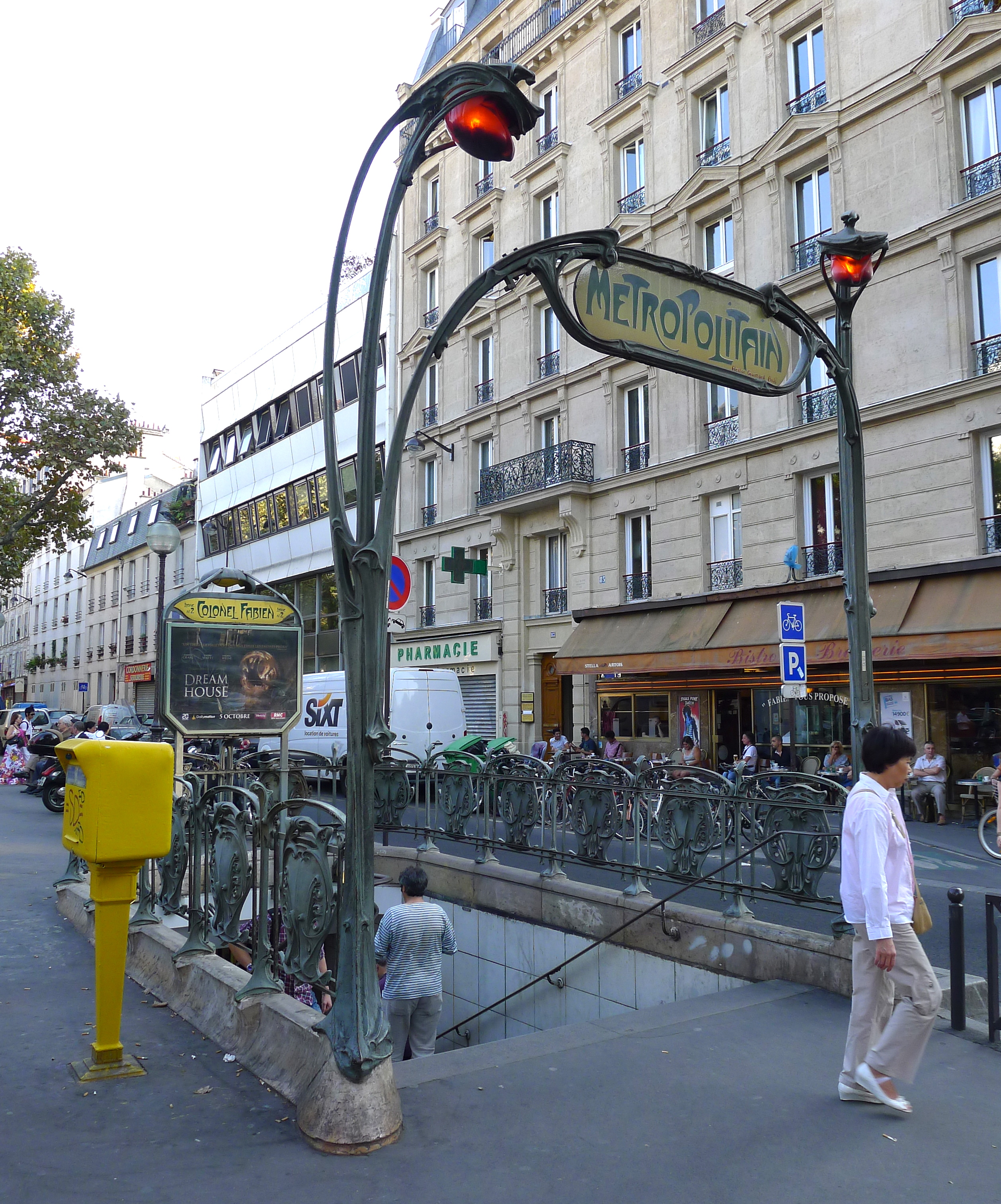Colonel Fabien (Paris Métro) on:
[Wikipedia]
[Google]
[Amazon]
Colonel Fabien () is a station on
 The station was opened on 31 January 1903 as part of the extension of line 2 from
The station was opened on 31 January 1903 as part of the extension of line 2 from
Paris Métro Line 2
Paris Métro Line 2 ( French: ''Ligne 2 du métro de Paris'') is one of the sixteen lines of the Paris Métro. Situated almost entirely above the former customs barrier around the capital (''Boulevards extérieurs''), it runs in a semicircle in ...
, on the border of the 10th
10 (ten) is the even natural number following 9 and preceding 11. Ten is the base of the decimal numeral system, by far the most common system of denoting numbers in both spoken and written language. It is the first double-digit number. The rea ...
and 19th arrondissements under the ''Boulevard de la Vilette''.
Location
The station is located under Boulevard de la Villette, to the south-east ofPlace du Colonel Fabien
The Place du Colonel Fabien (in English: "Colonel Fabien Square") is a square in Paris, France.
Before the liberation of Paris, the square was called the ''Place du Combat'', but it was renamed in honour of the French communist resistance hero, ...
. Oriented approximately along a north-west / south-east axis, it is positioned between the ''Jaurès'' and ''Belleville'' metro stations. In the direction of ''Porte Dauphine'', this is the last underground station before the above-ground section of the line.
History
 The station was opened on 31 January 1903 as part of the extension of line 2 from
The station was opened on 31 January 1903 as part of the extension of line 2 from Anvers
Antwerp (; nl, Antwerpen ; french: Anvers ; es, Amberes) is the largest city in Belgium by area at and the capital of Antwerp Province in the Flemish Region. With a population of 520,504,
to ''Bagnolet'' (now called Alexandre Dumas
Alexandre Dumas (, ; ; born Dumas Davy de la Pailleterie (), 24 July 1802 – 5 December 1870), also known as Alexandre Dumas père (where '' '' is French for 'father', to distinguish him from his son Alexandre Dumas fils), was a French writer ...
). It was originally named ''Combat'' after the ''Place du Combat'', which was named after the ''Barrière du Combat'', a gate built for the collection of taxation as part of the Wall of the Farmers-General
A wall is a structure and a surface that defines an area; carries a load; provides security, shelter, or soundproofing; or, is decorative. There are many kinds of walls, including:
* Walls in buildings that form a fundamental part of the supe ...
; the gate was built between 1784 and 1788 and demolished after the Paris Commune
The Paris Commune (french: Commune de Paris, ) was a revolutionary government that seized power in Paris, the capital of France, from 18 March to 28 May 1871.
During the Franco-Prussian War of 1870–71, the French National Guard had defended ...
of 1871. Its name reflected the animal fighting held there between 1778 and 1850. On 19 August 1945 the ''Place'' and station were renamed after Colonel Pierre-Georges Fabien, who shot a German soldier to death at Barbès – Rochechouart metro station, marking the beginning of the armed French Resistance
The French Resistance (french: La Résistance) was a collection of organisations that fought the German occupation of France during World War II, Nazi occupation of France and the Collaborationism, collaborationist Vichy France, Vichy régim ...
in Paris.
As part of the RATP '' Renouveau du métro'' program, the station was renovated in the course of the 2000s.
In 2020, with the Covid-19 crisis, 2,378,863 passengers entered this station, which places it at the 94th position of metro stations for its use.
Passenger services
Access
The station has a single entrance called ''Boulevard de la Villette'', leading to the central median of this boulevard facing no. 83. Made up of a fixed staircase, it is adorned with a Guimard entrance designed in 1900, and is the registered as a historical monuments by the decree of 29 May 1978.Station layout
Platform
Colonel Fabien is a standard configuration station. It has two platforms separated by the metro tracks and the vault is elliptical. The decoration is of the style used for the majority of the metro stations with bevelled white ceramic tiles covering the walls, the vault, the tunnel entrances and the outlets of the corridors, while the lighting is provided by two tube canopies. The advertising frames are metallic and the name of the station is written inParisine
Parisine is a typeface created by Jean-François Porchez. Distributed by Typofonderie.
It is used in Paris Métro, tramways, buses and RER parts operated by the RATP Group in Île-de-France. Starting in 2015, the Osaka City Subway in Japan a ...
font on enamelled plates. The seats are the ''Motte'' style in blue.
Bus connections
The station is served by lines 46 and 75 of theRATP Bus Network
The RATP bus network covers the entire territory of the city of Paris and the vast majority of its near suburbs.
Operated by the Régie Autonome des Transports Parisiens (RATP), this constitutes a dense bus network complementary to other public ...
.
References
Paris Métro stations in the 10th arrondissement of Paris Paris Métro stations in the 19th arrondissement of Paris Railway stations in France opened in 1903 {{Paris-metro-stub